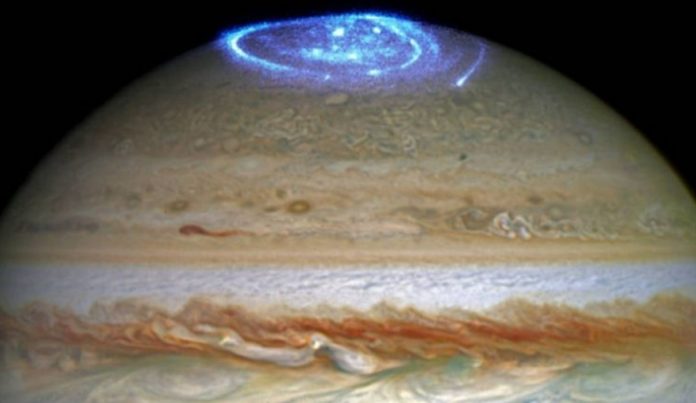A complex “tug of war” lights up auroras in Jupiter’s upper atmosphere, a combination of data from NASA’s Juno and the Hubble Space Telescope reveals.
Research published in the Journal of Geophysical Research: Space Physics describes the current delicate cycle driven by Jupiter’s rapid rotation and the release of sulfur and oxygen from volcanoes on its moon, Io.
Researchers from the University of Leicester’s School of Physics and Astronomy used data from Juno’s Magnetic Field Survey (MAG), which measures Jupiter’s magnetic field from orbit around the gas giant, and observations from the Juno Telescope’s Imaging Spectrograph. Space transported by the Hubble Space Telescope.
Their research provides the strongest evidence yet that Jupiter’s powerful auroras are associated with an electrical current system that acts as part of a tug-of-war with material in the magnetosphere, the region dominated by the Earth’s enormous magnetic field. planet.
Dr Jonathan Nichols, reader on planetary auroras at the University of Leicester and corresponding author on the study, said: “We’ve had theories linking these electric currents and Jupiter’s powerful auroras for over two decades now, and it was so exciting to be able to finally test them by looking for this relationship in the data. And when we plotted one against the other I nearly fell off my chair when I saw just how clear the connection is.”
“It’s thrilling to discover this relation because it not only helps us understand how Jupiter’s magnetic field works, but also those of planets orbiting other stars, for which we have previously used the same theories, and now with renewed confidence.”
Despite its enormous size, with a diameter more than 11 times that of Earth, Jupiter rotates about once every nine and a half hours.
Io is similar in size and mass to Earth’s moon, but orbits Jupiter at an average distance of 422,000 km; about 10% farther. With more than 400 active volcanoes, Io is the most geologically active object in the Solar System.
Scientists had long suspected a link between Jupiter’s auroras and material ejected from Io at speeds of many hundreds of kilometers per second, but the data captured by Juno proved ambiguous.
Much of the material released by Io is ejected from Jupiter by the planet’s rapidly rotating magnetic field, and as it moves outward, its rotational speed tends to slow. This results in an electromagnetic tug-of-war, in which Jupiter tries to keep this material spinning at its rotational speed through a system of electrical currents that flow through the planet’s upper atmosphere and magnetosphere.
The component of the electrical current flowing out of the planet’s atmosphere, carried by electrons thrown down along magnetic field lines into the upper atmosphere, was thought to drive Jupiter’s main auroral emission.
However, before Juno’s arrival, this idea had never been tested, as no spacecraft with relevant instruments had previously orbited close enough to Jupiter. And when Juno arrived in 2016, the expected signature of such an electrical current system was not reported, and while such signatures have since been found, one of the big surprises of the Juno mission has been to show that nature of electrons over Jupiter’s polar regions is much more complex than initially expected.
The researchers compared the brightness of Jupiter’s main aurora emission with simultaneous measurements of the electrical current flowing from the Solar System’s largest planet in the magnetosphere during an early part of Juno’s mission.
These auroras were observed with instruments aboard the Hubble Space Telescope, in Earth orbit. By comparing sunrise-side current measurements to the brightness of Jupiter’s auroras, the team demonstrated the relationship between the intensity of the aurora and the strength of the magnetospheric current.
You were reading: An electromagnetic ‘tug of war’ lights up Jupiter’s auroras
